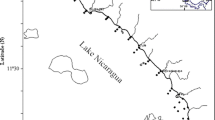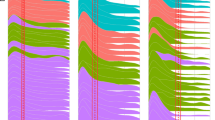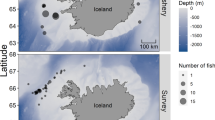Abstract
The gonosomatic or gonadosomatic index [GSI=(ovary weight/fish weight)×100] has been widely used in fisheries science and experimental reproductive studies as a simple, low-cost measure of reproductive condition. However, its properties have not been fully evaluated, and several pitfalls, such as size-dependence and changes in ovarian allometry, may invalidate its use. In the present study, we examined ovarian allometry and the appropriateness of GSI for assessing ovarian activity in the Mediterranean sardine Sardina pilchardus. The analysis was based on a large sample of histologically scored females collected over an annual cycle in the eastern Mediterranean (Aegean and Ionian Seas). First, we examined GSI dependence on fish size by comparing ovary weight–on–fish weight relationships in different stages of oocyte development. The effects of recent spawning (incidence of postovulatory follicles) and intensity of follicular atresia were also addressed. In a subsequent step of the analysis, we applied generalized linear models (GLMs) to analyze the relationship between GSI and histological stage, taking into account the parallel effects of additional factors related to geographical region, month of capture, fish length and energetic reserves (fat stage, hepatosomatic index—HSI). Ovarian growth was isometric in all stages of oocyte development and states of atresia, but altered to positive allometric at the stage of oocyte hydration. Oocyte growth and intensity of atresia significantly affected GSI. Fish length, geographical region, month of capture, fat stage and HSI did not substantially affect GSI, further strengthening the appropriateness of the index for the Mediterranean sardine. Finally, we provide first evidence, based mainly on available (but yet limited) published information for other fish species, that: (1) the pattern of ovarian allometry may not be altered by fecundity variations and (2) the pattern of ovarian allometry may reflect the pattern of oocyte growth (i.e. isometric vs. allometric ovarian growth could reflect group-synchronous vs. -asynchronous oocyte development). Alternatively, the pattern of ovarian allometry could reflect the presence or absence of size dependency in the relative fecundity (eggs per gram of body weight) and/or egg size. The isometric ovarian growth in the Mediterranean sardine could be attributed to the lack of such size-dependent effects.




Similar content being viewed by others
References
Bolger T, Connolly PL (1989) The selection of suitable indices for the measurement and analysis of fish condition. J Fish Biol 34:171–182
Chambers JM, Hastie TJ (1992) Statistical models in S. Chapman and Hall, London
Clark C (1981) Staining procedures. Williams and Wilking, Baltimore
Coward K, Bromage N (1999) Spawning frequency, egg size and ovarian histology in groups of Tilapia zillii maintained upon two distinct food ration sizes from first-feeding to sexual maturity. Aquat Living Resour 12:11–22
Davis TLO, West GJ (1993) Maturation, reproductive seasonality, fecundity, and spawning frequency in Lutjanus vittus (Quoy and Gaimard) from the north west shelf of Australia. Fish Bull (Wash DC) 91:224–236
DeMartini EE (1991) Annual variations in fecundity, egg size, and the gonadal and somatic conditions of queenfish Seriphus politus (Sciaenidae). Fish Bull (Wash DC) 89:9–18
DeMartini EE, Lau BB (1999) Morphometric criteria for estimating sexual maturity in two snappers, Etelis carbunculus and Pristipomoides sieboldii. Fish Bull (Wash DC) 97:449–458
DeVlamming V, Grossman G, Chapman F (1982) On the use of the gonosomatic index. Comp Biochem Physiol A 73:31–39
Erickson DL, Harris MJ, Grossman GD (1985a) Ovarian cycling of tilefish, Lopholatilus chamaeleonticeps Goode and Bean, from the South Atlantic Bight, USA. J Fish Biol 27:131–146
Erickson DL, Hightower JE, Grossman GD (1985b) The relative gonadal index: an alternative index for quantification of reproductive condition. Comp Biochem Physiol A 81:117–120
Ganias K (2003) Oceanographic and biological study of sardine Sardina pilchardus (Walb., 1792) ichthyoplankton production in coastal waters of central Greece. PhD thesis, University of Thessaly, Magnesia
Ganias K, Somarakis S, Machias A, Theodorou A (2003) Evaluation of spawning frequency in a Mediterranean sardine population. Mar Biol 142:1169–1179
Ganias K, Somarakis S, Machias A, Theodorou A (2004) Pattern of oocyte development and batch fecundity in the Mediterranean sardine. Fish Res (Amst) 67:13–23
Garcia-Berthou E, Moreno-Amich R (1993) Multivariate analysis of covariance in morphometric studies of the reproductive cycle. Can J Fish Aquat Sci 50:1394–1399
Gould SL (1966) Allometry and size in ontogeny and phylogeny. Biol Rev 41:587–640
Gutreuter S (1990) Comments. Properties of relative weight and other condition indices. Trans Am Fish Soc 119:1049–1051
Hunter JR, Macewitz B (1985) Measurement of spawning frequency in multiple spawning fishes. In: Lasker R (ed) An egg production method for estimating spawning biomass of pelagic fish: application to the northern anchovy, Engraulis mordax. NOAA (Natl Ocean Atmos Adm) Tech Rep NMFS (Natl Mar Fish Serv) 36:79–93
Hunter JR, Lo NCH, Leong HJ (1985) Batch fecundity in multiple spawning fishes. In: Lasker R (ed) An egg production method for estimating spawning biomass of pelagic fish: application to the northern anchovy, Engraulis mordax. NOAA (Natl Ocean Atmos Adm) Tech Rep NMFS (Natl Mar Fish Serv) 36:67–77
Jons GD, Miranda LE (1997) Ovarian weight as an index of fecundity, maturity, and spawning periodicity. J Fish Biol 50:150–156
Kwok KY, Ni I-H (1999) Reproduction of cutlassfishes Trichiurus spp. from the South China Sea. Mar Ecol Prog Ser 176:39–47
Marshall CT, Yaragina N, Lambert Y, Kjesbu O (1999) Total lipid energy as a proxy for total egg production by fish stocks. Nature 402:288–290
McCullagh P, Nelder JA (1983) Generalized linear models. Chapman and Hall, London
Milton DA, Blaber SJM, Rawlinson NJF (1994) Reproductive biology and egg production of three species of Clupeidae from Kiribati, tropical central Pacific. Fish Bull (Wash DC) 92:102–121
Murayama T, Shirashi M, Aoki I (1994) Changes in ovarian development and plasma levels of sex hormones in the wild female Japanese sardine (Sardinops melanostictus) during the spawning period. J Fish Biol 45:235–245
Nikolsky GV (1963) The ecology of fishes. Academic, London
Osorio AC, Acero A (1996) Reproduction of Anchovia clupeoides and Anchoa parva (Pisces: Engraulidae) in two Caribbean swamps of Colombia. Rev Biol Trop 44:781–793
Shapiro DY, Savody Y, McGehee MA (1993) Periodicity of sex change and reproduction in the red hind, Epinephelus guttatus, a protogynous grouper. Bull Mar Sci 53:1151–1162
Somarakis S (2004) Marked interannual differences in reproductive parameters and daily egg production of anchovy (Engraulis encrasicolus) in the northern Aegean Sea. Belg J Zool[Suppl] (in press)
Somarakis S, Koutsikopoulos C, Machias A, Tsimenides N (2002) Applying the daily egg production method (DEPM) to small stocks in highly heterogeneous seas. Fish Res (Amst) 55:193–204
Taylor RG, Grier HJ, Whittington JA (1998) Spawning rhythms of common snook in Florida. J Fish Biol 53:502–520
Thorsen A, Fyhn H (1996) Final oocyte maturation in vivo and in vitro in marine fishes with pelagic eggs; yolk protein hydrolysis and free amino acid content. J Fish Biol 48:1195–1209
Venables WN, Ripley BD (1997) Modern applied statistics with S-PLUS, 2nd edn. Springer, New York Heidelberg Berlin
Wallace AR, Selman K (1981) Cellular and dynamic aspects of oocyte growth in teleosts. Am Zool 21:325–343
West G (1990) Methods of assessing ovarian development in fishes: a review. Aust J Mar Freshw Res 41:199–222
Acknowledgements
This study was partially funded by an EU-DG XIV study project (contract no. 98/039). Thanks are due to the coordinator of the project, Dr. A. Machias. The experimental work complied with the current laws of Greece.
Author information
Authors and Affiliations
Corresponding author
Additional information
Communicated by O. Kinne, Oldendorf/Luhe
Rights and permissions
About this article
Cite this article
Somarakis, S., Ganias, K., Tserpes, G. et al. Ovarian allometry and the use of the gonosomatic index: a case study in the Mediterranean sardine, Sardina pilchardus. Marine Biology 146, 181–189 (2004). https://doi.org/10.1007/s00227-004-1419-2
Received:
Accepted:
Published:
Issue Date:
DOI: https://doi.org/10.1007/s00227-004-1419-2




